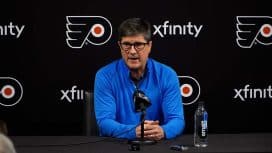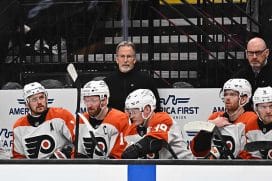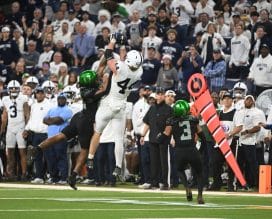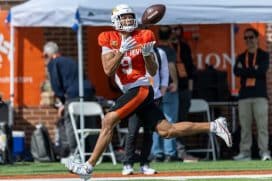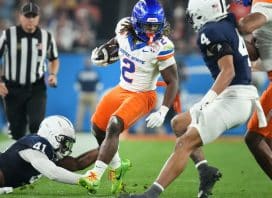Writer: Kevin Durso
Ruben Amaro Resembles Mentor in Hunter Pence Deal
Posted by Kevin Durso

Philliedelphia/Kevin Durso
Sunday, July 24th. The Phillies are in the middle of a four-game series against the Padres, working on their fifth straight win. But, while all that is going on, the man behind the 2008 World Champion Phillies was receiving baseball’s highest honor. Pat Gillick was being inducted into baseball’s Hall of Fame in Cooperstown.
Gillick received such an honor for being the behind-the-scenes leader of three different World Champion teams, one being the Phillies’ 2008 triumph, and another being directly linked to the Phillies forever. Gillick was also the GM of the championship teams in Toronto in 1992 and 1993,
the latter of course coming against the Phillies. But, Gillick’s Hall of Fame story evolved by just being successful, from those back-to-back titles in Toronto, to making Baltimore a winner again, to a record-setting 116-win team in Seattle, to a championship team in a city starving for one in Philadelphia.
Looking deeper into what Pat Gillick did for the Phillies in 2008, and all the years leading up to it, you have to recognize that he made deadline moves that made the team better every year. Gillick’s first move involved getting Ryan Howard the starting job full time, as he traded Jim Thome to Chicago for Aaron Rowand. He was the man behind drafting Domonic Brown, as well as valuable future trade pieces like Kyle Drabek and Jason Donald. Perhaps one of Gillick’s early notables was on July 30th, when he made a deadline splash of a different kind, sending Bobby Abreu with Cory Lidle to the Yankees for prospects. He claimed the Phillies were still at least a year away from contending, making it the ultimate seller move. He did make a trade for Jamie Moyer, which added veteran presence, as well as guided the Phillies’ rotation to a much better go in the years ahead.
He brought guys like Jayson Werth and Greg Dobbs into the mix for 2007. As the Phillies looked more like a contender, he brought guys like J.C. Romero in. The Phillies ended up in their first Postseason since 1993, when Gillick’s Blue Jays got the best of the Phillies in the Fall Classic. That run was short and sweet, with an unhappy ending, but it got the Phillies a taste of what 2008 was to bring.
Offseason moves for Geoff Jenkins, Chad Durbin, Pedro Feliz, Eric Bruntlett, and Brad Lidge brought the Phillies more versatility on all ends. At the midpoint of the season, Gillick made a splash getting Joe Blanton from the A’s, and adding Matt Stairs and Scott Eyre. By the end of the season, the Phillies were champions.
The next season, the reins were in the hands of Ruben Amaro Jr., who mentored under Gillick. Right away, he was in the middle of some big moves. At the deadline of 2009, the Phillies needed a pitcher. The Phillies wanted Roy Halladay. They got Cliff Lee. And all that did was get them to the
World Series for the second straight season.
Amaro’s only mistake was mixed with success. The Phillies had another chance at Halladay that offseason, and finally got him. But, in doing so, they had to give up some valuable prospects. So, they sent Lee, beloved by the fans, and feeling quite at home in Philadelphia, to Seattle. Later that season, Amaro was back at it again at the deadline, getting Roy Oswalt.
Amaro’s real mark as a GM came this season. With the Phillies not even on the radar for Lee, who was back on the market, Amaro pulled out all the stops, and signed Lee to a mega-deal. The move put Amaro on the next level of GMs, and made him a local hero for getting the job done. The Phillies and mainly fans, spent 2010 watching Lee dominate opponents. It hurt even more when the Phillies weren’t part of a World Series that Lee was with the Texas Rangers. The prospects they got for Lee certainly weren’t worth it either. Now, it all seemed worth it and then some. In the end, the Phillies got two of the best pitchers in baseball without much sacrifice. Sure, the Phillies had sacrificed a lot in terms of the future, but they hadn’t at all really. A perfect example of that is Amaro’s latest move. Looking for a hitter, Amaro put together a deal that kept some of his youngest future stars in town, while getting the name he wanted. Hunter Pence became a Phillie just five days after Gillick’s induction. It was a move that Gillick would be proud of.
To get a player like Pence, it seemed that names like Domonic Brown or Vance Worley would surely come up, and even more likely be included. Instead, four prospects went to Houston, not members of the current roster. And while the deal cost Brown a spot on the Phillies, and sent him back to minors, it was all for the better. Amaro’s deal focuses on the future of the team as much as it does the present.
The reason we can talk about Amaro as such a great GM is because of how he learned from Gillick. Gillick eventually bought into the Phillies being a contender, and carried that to a championship team. Gillick did it the hard way, bringing in lesser names of great talent, and avoiding the
largest splashes. Amaro is in a spot that Gillick wasn’t. The Phillies are one of baseball’s most recognizable franchises. Players want to play there, and teams are willing to make deals. But most importantly, Amaro is willing to forgo the future, in the term of unproven prospects, for current talent that can help the team win now. But, they could have had Carlos Beltran before Pence. Beltran was a two-month rental. Pence is under a two-year contract, with a bright future ahead of him. Pence wins out in the end. With Beltran likely back on the market after this season, so are the Phillies then, who get to keep their deadline acquisition for the long-term.
The Phillies haven’t been afraid to get the big name and lock him up. It’s the reason fans have bought in. It’s the reason the nation fears the Phillies like they do the Yankees and Red Sox. It’s the reason players like coming here. Players want to be on a team that wants to win. The Phillies know they are one of those teams, and use it to their advantage. The fans sense that they want to win, and so they bring a packed house every night, because it’s worth it to see a winner.
What a difference a decade makes. When Pat Gillick took over this team, the Phillies were working on a Postseason drought that would hit 14 seasons before finally becoming division champs. Now, that seems to be a regular expectation. Winning the pennant is almost an annual expectation. And
the ultimate goal, is still the ultimate goal. But, with guys like Gillick and Amaro leading the charge, and getting the talent needed to win, it doesn’t make that sometimes impossible dream seem so impossible.
